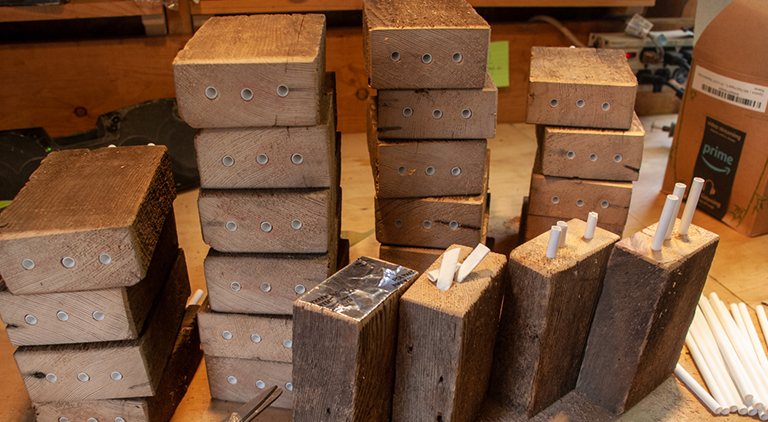
The threat of extinction
The global bee population has been declining steadily for decades now. Here in Ireland, we have seen a marked decrease in bee numbers since the 1980s. According to experts, the distribution of 42 bee species has declined by more than 50% over the last 40 years. There are numerous possible causes of this dramatic decline, but most scientists blame a combination of habitat destruction, climate change, excessive pesticide use, changes in land use, and loss of biodiversity.
Why we need the bee
As I mentioned in a blog post a couple of weeks ago, this trend should worry all of us. While much focus is being directed towards the looming disaster of climate change, the rapidly declining bee population represents, arguably, a more immediate worry for the survival of organised life on this planet. Were bees to fall into the abyss of extinction, life for most creatures, human beings included, would become all but impossible. Bees are our primary pollinators, after all. They collect pollen from plants to feed their colony, and in doing so they carry pollen from plant to plant. Their survival is therefore inextricably linked to the process of plant reproduction. Without them, this planet will face a food crisis of unprecedented scale.
Now, I don’t go in for scaremongering. Personally, I’m more interested in solutions than in painting an apocalyptic picture of what a post-bee world will look like. The reality is that we can all do our bit to preserve, protect and promote our local bee population. It requires minimal effort, and you don’t have to own a large tract of land to make a meaningful contribution.
Grow plants that have pollen and nectar
It may seem an obvious point, but not all flowers are equally attractive to bees. You need to know the right plants and flowers to grow. To foster the bee population in your back garden, you should grow a wide range of flora that will provide a continuous flowering period from early spring until late autumn. Set aside as much ground as you can afford for a wildflower patch and then consider what plants are most appropriate for achieving your aim.
Now, I am the first to admit that I know very little about botany, so figuring out the right plants demanded a bit of research. Thankfully, many experts have shared their knowledge online, so getting the right information was a fairly easy task. Existing research suggests that catering for bees in each season requires a wide array of flowers. For the summer months, we should try to ensure that there are plenty of the following plants in our garden: lavander, agastache, cabious, comfrey, foxglove and cardoon. When the season turns to autumn, you should have sedums, dahlias, Verbena bonariensis, asters, Japanese anemones and Actaea simplex. For winter, try to maintain plants like snowdrops, ivy, winter aconites, crocuses, hellebores, mahonia and honeysuckle. And finally, for the spring months, a healthy amount of flowering cherry, hawthorn, bugle, crab apple, daffodils, grape hyacinth, pulmonaria and alliums will do the trick.
Dandelions and clover - they're not weeds!
If you find that you don’t have the time or the money to make an array of plant purchases, remember that many garden stores sell seed mixes that have been specially selected with pollinators in mind. Here at Agridirect.ie and Kennedys Home and Garden, we currently sell a mix that includes an excellent range of pollinating seeds. Mixes are very easy to sow and require very little attention; and while they don't contain all of the plants I have mentioned above, they do contain a high volume of pollinator-friendly flowers such as poppy and crimson clover, as well as plenty of buckwheat.
Aside from growing more flowers, remember that some of the most common garden wildflowers, such as dandelions and clover, are a vital natural source of food for bees. Try not to look at these as weeds that need to be sprayed or uprooted, but as a valuable part of nature's plan to sustain life.
Building bee nests for solitary bees
There is a common misconception that all bees live in hives. But in reality, there are also many species of solitary bee, such as mining bees and wool-carder bees, now facing extinction as well. These bees have no hive to defend, but are among the most prolific of pollinators. You can help to support these lone rangers by building nests for them to live in. There are several ways of doing this, and all are quick and easy. Arguably the most straightforward approach is to drill some holes into untreated wood (see below) and leave the timbers somewhere that is safe from heavy rain and blistering sun.

Another method involves using a terracotta flowerpot. Place some moss in the bottom of the pot and then fill it with good quality, dry hay. Turn the pot upside down and half-bury in a sheltered place such as a hedge or a grove of trees.
Other experienced bee enthusiasts recommend using a plastic bottle. If you decide to go with this approach, simply stuff dried out twigs and stems into the bottle. Leave it in a sheltered place and wait for a bee to land in it.
Thanks for reading
It really is crucial that as many people as possible become bee enthusiasts in the coming years. This short guide to supporting the bee population is not intended to be a comprehensive account, but an introduction only. If you have any thoughts on this topic, please don’t hesitate to let us know in the comments section. As always, we are very eager to hear what you have to say.










